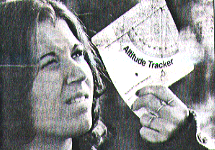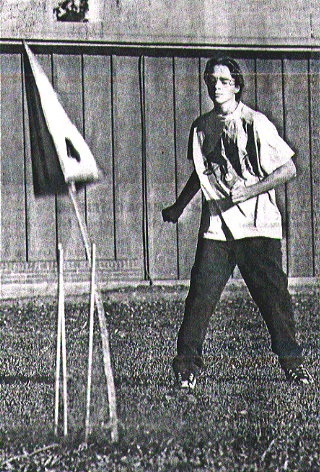
Teacher Assistant Julie Kemp, 16, uses a gauge to determine
how hight the rockets sour.
Interactive NASA trip
will aid student work
| Tuesday's broadcast on KIXE Channel 9 will
coincide with space-related science projects launched last month by Shasta
High School Students.
By Jeff Munson
R-s staff reporter
For many teens. the final frontier in adolescence is to graduate from high
school.
But a group of Shasta High students is looking to the heavens and NASA for
answers to a series of space-related science projects launched last month
by teacher Brian Grigsby.
On Tuesday, about 60 Shasta students will joint their peers from around
the country in a live, interactive "field trip" from NASA headquarters in
Cape Canaveral, Fla.
The program, called "Countdown" begins at 10 a.m. and will be broadcast on
Redding Public Television KIXE Channel 9. "Countdown" will focus on the
recent launch of the Mars Global Surveyor satellite and the planned
December mission of another unmanned space vehicle the Mars
Pathfinder.
|
During the broadcast, students will have a chnace to ask
questions via e-mail to a team of NASA scientists and engineers who have
worked on the two Mars spacecraft.
Tuesday's program marks the first time Shasta students have
______________
"I thought it would be nice for them to see how science is changing and
is constantly pushing the limits of what we know."
Teacher Brian Grigsby
Shasta High School
______________
participated in interactive television broadcasts carried by
KIXE. The public television station plans to offer more next year.
"For students, the electronic field trips are a unique learning
experience that keeps them curren with the technology of the times," said
KIXE spokeswoman Kathy Coulter.
Teacher Grigsby said he hopes "Countdown" will provide an
engaging way of teaching students about space programs. NASA and the Mars
expeditions.
| | 
Shasta student Tobe Marchione, 15, pulls a cord that
uncorks a model rocket. He and partner Jason Norderum, 14, built the
rocket with a two-liter plastic bottle and cardboard.
|
"I thought it would be nice for them to see how science is changing and is
constantly pushing the limits of what we know," he said.
To prepare for the broadcast, students ahve done experiements related to
the Mars projects.
In one study, students placed a tiny camera on a remote control truck and
maneuvered the truck through a "Martian" obstacle course by watching it on
a computer screen.
The experiment was to demonstrate how
scientists plan to maneuver the unmanned space vehicle by way of
satellite, as it roams the Martian landscape to collect samples of the
surface.
|
In another experiment, students worked in pairs to build rockets from
two-liter plastic soda bottles.
The rockets were launched by compressing 60 pounds of air into empty
bottles and then uncorking them from a launch pad.
In one class, students Harlen Robinson, 16, and Jennifer Webb, 15, made a
rocket that climbed 160 feet before plunging into a tree. The pair said
they used aerodynamic fins that were stronger than ones used by their
classmates.
"The stronger the fins, the higher it flies," Jennifer
said. |
|





![]()